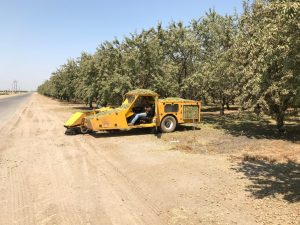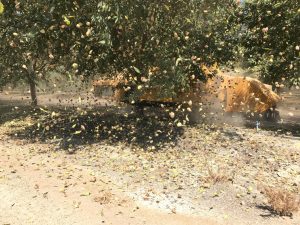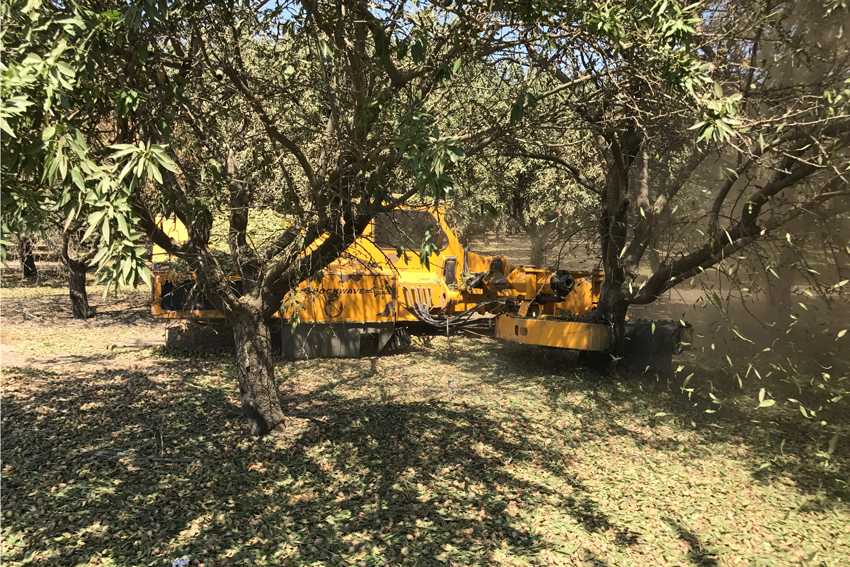
California provides perfect climate for almond growth
California is widely known for its famous beaches, amusement parks and movie stars. However, what many people in the United States do not realize is that The Golden State is also the fifth largest supplier of food in the entire world.
For almond farmers in the San Joaquin Valley, harvesting is a hectic and busy process. However they are busy long before harvest season preparing the trees and ground for what they hope is a successful harvest.
Central California almond farmer John Nale works year round to ensure everything goes smoothly come harvest time on his farm near Biola.
“We have to start preparing months in advance, making sure the almond floor is glass flat,” Nale said. “It needs to be like a paved road and it needs to be irrigated. That makes your harvesting go easier. When you have a clean and hard and flat field it makes everything better.”
The Central Valley of California is one of the few Mediterranean growing regions in the world. We have dry warm summers and cool wet winters with short periods of frost. This is ideal for almonds as they are able to go dormant during winter and rest while the dry summers minimize weather related risks that may cause damage to the trees and crop during the growing season. — Bryant Elkins
Almonds are one of California’s biggest commodities. An amazing 90 percent of almonds produced in the entire world are from California, that’s almost 99 percent of all almonds grown in the United States.
Almond farmer Bryant Elkins’ interested in agriculture began at a very young age. In high school, he was a part of FFA before obtaining a B.S. in Agricultural Business at Colorado State University.
Elkins believes California’s conditions are ideal for growing crops.
“The Central Valley of California is one of the few Mediterranean growing regions in the world,” Elkins said. “We have dry warm summers and cool wet winters with short periods of frost. This is ideal for almonds as they are able to go dormant during winter and rest while the dry summers minimize weather related risks that may cause damage to the trees and crop during the growing season.”
Many farmers in California rushed to plant almonds in recent years because of the high demand and good price. However, the more almond trees farmers plant, the less valuable the crop becomes.
While still profitable, the market for almonds has dropped steadily in recent years. Elkins believes the prices will continue to decline as farmers continue to plant more almonds than needed.
“Prices are currently still profitable though at much lower levels,” Elkins said. “Due to the very high prices and profits experienced a couple of years ago, a lot of new acres of almonds have been planted. It is not known exactly how this will affect the market but as supply grows it may put downward pressure on prices in the next few years as the new trees come into production.”

California farmers are almost constantly looking for ways in which they can increase their yield or cut down production cost. The state often puts more regulations on farmers compared to those in other states because of environmental issues.
Farmer Shannon Iest believes California farmers can often be at a disadvantage because of regulations and a lack of water storage.
“We have more water concerns and a lot more regulations than farmers in other states,” Iest said. “It would be nice if the state built more infrastructures for water storage. Although we have enough water at the moment, we don’t have enough storage for water should we get a drought again.”
As the summer months wind down and the days begin to get shorter, the harvesting equipment begins to come out of storage. After months of preparation, farmers get to see their hard work pay off. Compared to how much work it takes to prepare an orchard, harvesting is relatively quick. However the work doesn’t stop there, almost as soon as the trucks filled with almonds drive away, work begins for next years harvest.
Do you have any questions about almond farming? If so, leave a comment below!
For more articles, read: Operations rally around Texas during Hurricane Harvey or Father shares hope, kindness beyond Molly Day.
This author can be reached via Facebook, Instagram and Twitter.










![[Video] 100th CSPA Spring Journalism Conference](https://thefeather.com/wp-content/uploads/2024/04/20240308-cspa-crown-002.jpg)
![[Video] New York Day 4](https://thefeather.com/wp-content/uploads/2024/04/NY-trip-day-4-JC-.jpg)





